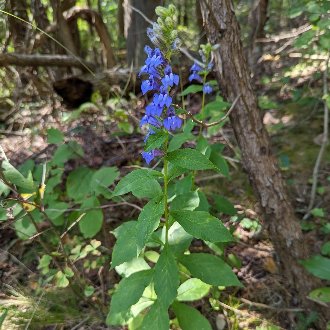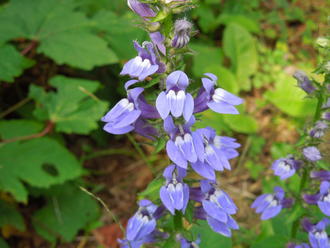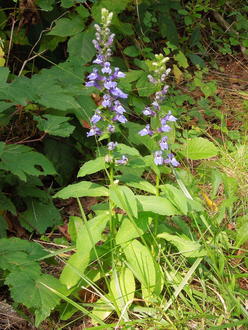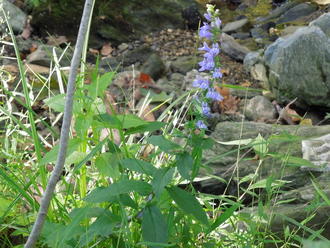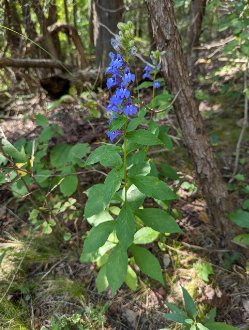Great Blue Lobelia (Lobelia siphilitica L.)
↑Summary
A perennial lobelia with a wide range in Eastern North America, particularly common in the northeast and upper midwest.
↑Range - Expand
| Legend | Color |
| Native | |
| Native or Not Present | |
| Extirpated |
This tentative map is based on our own research. It may have limited data on Canada and/or Mexico, and there is some subjectivity in our assignment of plants as introduced vs. expanded. Read more in this blog post.
Although this plant occurs somewhere in each of these regions, it may only occur in a small part of some or all of them.
↑Habitat
Found in a variety of partly-sunny, moist-to-wet habitats. Natural habitats include openings and borders in bottomland and floodplain forests, moist black soil prairies, wet meadows, margins of ponds and rivers, swamps, and fens. Occasionally found in openings in rich, mesic forests in coves and sheltered slopes in the Appalachians. Also found in anthropogenic habitats including managed edges in bottomland forests, parks or gardens, especially those with bodies of water, roadside ditches, and low, moist areas in pastures.
Typically limited to moist to wet conditions, and often found on sites that experience temporary flooding. Mostly found in partial sun, but ranges into full sun on the wettest sites, and occasionally ranges into light shade. Usually restricted to fertile, loamy soils with close to neutral pH, or only slightly acidic. Limited to sites experiencing some vegetation-removing disturbance, but found both in pristine natural habitats with natural disturbance, usually flooding, as well as anthropogenic habitats with mowing or weedwhacking.
This is probably the most shade-tolerant of the eastern lobelias. Among the larger-flowering perennial lobelias, both cardinal flower (Lobelia cardinalis) and downy lobelia (Lobelia puberula) are more tolerant of sandy and acidic soils, and replace this species in the southeastern coastal plain. Lobelia cardinalis tolerates, but is also more restricted to wetter sites, whereas Lobelia puberula ranges into drier sites too but is more restricted to acidic soils. Palespike lobelia (Lobelia spicata) prefers similarly rich loamy soil, but sunnier, drier conditions. None of these species however grow as tall, and great blue lobelia tends to be more competitive on moist sites with rich, loamy soil and more competing vegetation.
↑Life Cycle
This species is a short-lived perennial. Germination time is opportunistic, and can occur at just about any time of year. Seeds germinate when soil is disturbed and vegetation is removed, leading light to reach the ground. Young plants initially grow only as a basal rosette, and often overwinter in this form, with leaves usually being evergreen.
We could not find information on whether or not this species forms a persistent seed bank, but it likely does, as many other Lobelia species have been reported germinating from seed banks, and species producing numerous tiny seeds that require exposed soil to germinate usually form persistent seed banks.
Stems, both on first-year plants and older plants alike, begin growing upright in spring and start blooming in mid to late summer. The bloom period is long, and, so long as conditions are favorable, plants will continue growing a longer flower spike, with new flowers at the top while seeds are maturing lower down on the plant. Under favorable conditions plants continue blooming for about 2 months, often well into fall.
Although plants require soil disturbance to establish, established plants are tolerant of significant competition from surrounding vegetation, and will often grow taller in the presence of competition, pushing up through surrounding plants.
On favorable sites, plants will reproduce vegetatively, with each plant forming multiple basal rosettes clustered a few inches apart; these will each then send up a new stem in the subsequent growing season.
Plants usually live only about 3-4 years, but can sometimes persist longer. They can be killed by drought, prolonged flooding, or heavy shade from taller vegetation. Some type of disturbance, often from flooding, is important for removing competing vegetation and allowing this species to persist on a site.
↑Uses
This species is widely cultivated in gardens as an ornamental plant, where it is valued for its showy flowers. In most of its range, it is the easiest of the Lobelias to grow in gardens. It benefits from mulching, but modern landscaping practices, prone to heavy overmulching often carried out in early spring, can often harm this plant by burying its basal rosettes before they begin to grow upward, and can make it less competitive against rhizomatous weeds.
It is frequently used in rain gardens, drainage basins, and wetland restorations. It is a good choice of plant for these uses on sites with rich soil.
↑Links & External Resources
• Lobelia siphilitica (Great Blue Lobelia) | Illinois Wildflowers (About This Site)
• Lobelia siphilitica (Great Blue Lobelia) | USDA PLANTS Database (About This Site)
• Lobelia siphilitica | Go Botany (About This Site)
• Lobelia siphilitica (Blue Cardinal Flower) | Missouri Botanical Garden Plant Finder (About This Site)
• Lobelia siphilitica | Biota of North America Project (BONAP) (About This Site)
• Lobelia siphilitica | NatureServe Explorer (About This Site)
• Lobelia siphilitica | Missouri Plants (About This Site)
• Great Blue Lobelia | Maryland Biodiversity Project (About This Site)
• Lobelia siphilitica (Blue Lobelia) | Minnesota Wildflowers (About This Site)
• Lobelia siphilitica L. var. siphilitica (Great Blue Lobelia) | Digital Atlas of the Virginia Flora (About This Site)



